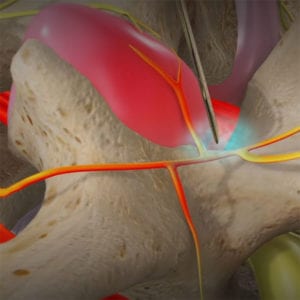Medial Branch Blocks
Medial branch blocks are a type of injection used to numb pain originating from the medial branch nerves that supply the facet joints. Due to the temporary nature of the medial branch block, it is often used to determine the potential efficacy of other, more permanent treatments. A medial branch block can be performed in either the cervical or lumbar portion of the spine, depending on the source of discomfort.
 Facet joints can become inflamed for a variety of reasons, such as an injury or a chronic condition. For lumbar facet joint pain, medial branch blocks can be used to relieve lower back achiness, which may spread from the buttocks and thighs. Cervical facet joint pain may include soreness in the neck, shoulders, or arms. These symptoms could be associated with conditions such as facet joint syndrome or spinal spondylosis.
Facet joints can become inflamed for a variety of reasons, such as an injury or a chronic condition. For lumbar facet joint pain, medial branch blocks can be used to relieve lower back achiness, which may spread from the buttocks and thighs. Cervical facet joint pain may include soreness in the neck, shoulders, or arms. These symptoms could be associated with conditions such as facet joint syndrome or spinal spondylosis.
During the procedure, the site of the injection is numbed with a local anaesthetic, allowing for a more comfortable experience for the patient. Once the area is numb, a contrast dye is injected into the injection site, allowing the physician to guide the medial branch block with the help of fluoroscopy imaging. The medial branch block injection is then administered directly into the inflamed nerve, blocking pain signals to the brain.
A medial branch block typically takes about 30 minutes. Although patients often experience relief after the injection, physicians typically recommend 1-2 days of rest following the procedure. After this rest period, patients may return to their normal activities. Patients who experience relief after a medial branch block are typically considered good candidates for other, more permanent pain relief procedures, such as radiofrequency neurotomy.
